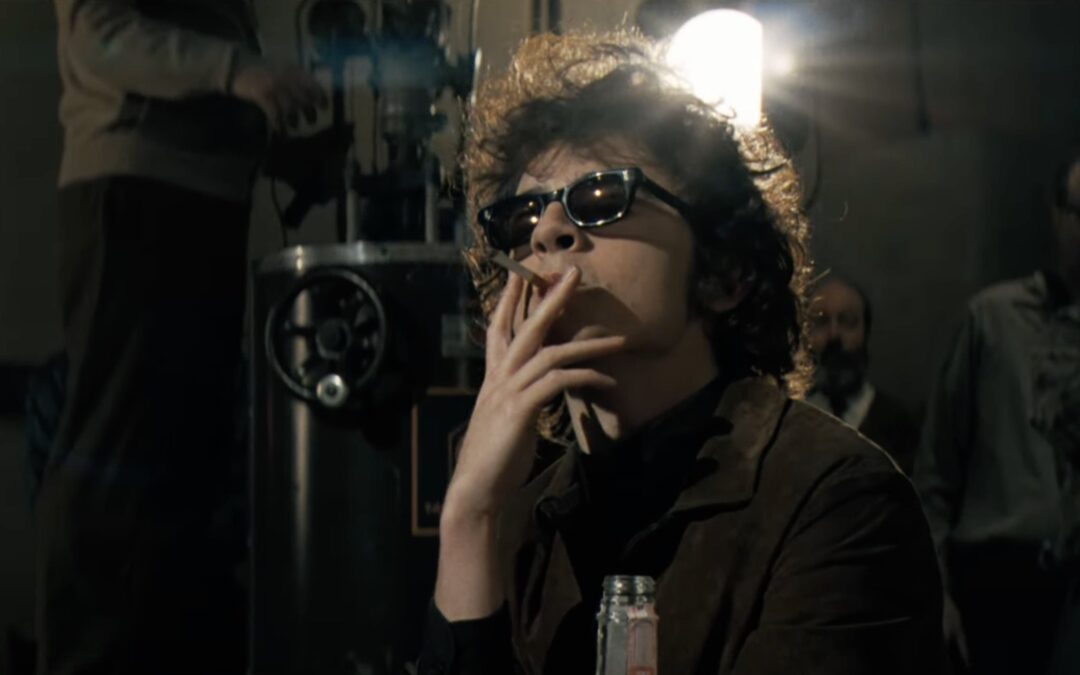The facts of their subject’s lives usually give music biopics a ready made story. Whether it is Mozart, Buddy Holly, or Biggie Smalls, it is rise and fall. So how does a filmmaker approach a subject like Bob Dylan, who rose in the early 1960s and is still going so strong at the age of 83 that he is appearing on stage in Mankato tonight?
In A Complete Unknown, James Mangold focuses on Dylan’s rise, and his theme is his escape from the clutches of the folk music movement. The film opens with Dylan arriving in New York in January 1961 and visiting his idol, Woody Guthrie, in hospital and follows as he catches the eye of Pete Seeger, catches rather more of Joan Baez, and becomes the Voice of a Generation with songs like “Blowin’ in the Wind” and “The Times They Are a-Changin’.”
But Woody Guthrie wasn’t Dylan’s first idol. When he accepted the Grammy for album of the year for Time Out Of Mind in 1998, he said:
I just wanted to say that one time when I was about 16 or 17 years old I went to see Buddy Holly play at the Duluth National Guard Armory. I was 3 feet away from him and he looked at me. I just have some kind of feeling, I don’t know how or why I know he was with us the whole time we were making this record in some kind of way.
This was January 31, 1959, just three days before Holly’s death and two years before his arrival in New York. When he graduated from Hibbing High School a few months later, Robert Zimmerman wrote in the yearbook that his ambition was “to join ‘Little Richard’.” The rock and rollers of the 1950s always loomed as large in Dylan’s mind as Woody Guthrie, a point Mangold makes early on. As early as November 1962, in the sessions for his second album, The Freewheelin’ Bob Dylan, which produced a string of masterpieces in the protest song genre, like “Masters of War” and “A Hard Rain’s A-Gonna Fall,” he recorded a rockabilly track, “Mixed Up Confusion.” Released as a single, it flopped, but when he finally went electric in 1965, the climax of Mangold’s story, there had been indications.
Working against this, in Mangold’s telling, are the attempts of Seeger and Alan Lomax — who probably gets a bum rap here — to hold Dylan to the pure path of folk music. Beyond that, Seeger is presented as not interested simply in musical authenticity, as Lomax is, but as wanting Dylan’s art to explicitly serve a political purpose. The first of Dylan’s LPs to meet a frosty reception from the folk crew was not April 1965’s semi-electric fifth album, but the all acoustic fourth, August 1964’s Another Side of Bob Dylan, because it rejected political themes for personal ones, with songs like “It Ain’t Me Babe,” “I Don’t Believe You,” or the scorching “Ballad in Plain D.” The conflict is resolved at the Newport Folk Festival in July 1965, when Dylan performs backed by pounding drums and screeching electric guitars and Seeger tries to turn the sound off. Dylan didn’t think his art should serve any purpose but his own and that he should be free to define that purpose.
The question of whether art should serve a personal or political purpose is an old one. It takes an exceptional talent to make deliberately political art without boring everyone and losing any lasting relevance. That is why Dylan’s protest songs — like “Only a Pawn in Their Game,” where the murder of Medgar Evers is used a jumping off point for an exploration of broader social and political forces — retain relevance while those of his contemporary, Phil Ochs, do not: “You’re not a folk singer,” Dylan is supposed to have said to Ochs as he pushed him out of a limousine once, “You’re a journalist.” Generally, the most profound artistic statements come incidentally.
Perhaps the biggest problem Mangold faces is Dylan himself. Of unsurpassed eloquence in song, in speech he mumbles, frequently nonsensically. As he retreated from his role as Voice of a Generation, he often hid behind wordplay, as when he answered the question of why his songs were so long with “Because I get paid by the word.” While Seeger’s side of the argument is put with clarity, Dylan’s has to worm its way out through such mumbled bon mots, but that is probably a reasonable depiction of the man: He put his side in songs like the coruscating “Positively 4th Street.” Timothee Chalamet — an actor I have previously found rather irritating — is excellent here, but Dylan remains, to a large extent, a complete unknown.
Dylan is still going so strong, in part, because he pioneered reinvention in popular music. The Hibbing rocker became a folk singer who became a rock poet who became a country singer who became…a few years ago, he released an album of Sinatra covers. What would Pete Seeger have made of that?

